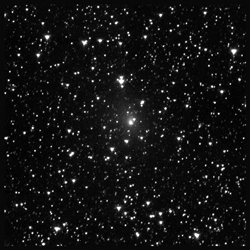EPOXI
Two intriguing investigations -- One flight-proven spacecraft
Outreach

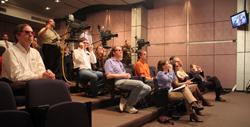 While most media folks tuned in via the webcast, several team members, friends, and personnel from NASA went down to NASA HQ for the press briefing about the icepuffs.
While most media folks tuned in via the webcast, several team members, friends, and personnel from NASA went down to NASA HQ for the press briefing about the icepuffs.
In the picture: Lori Feaga, Sebastien Besse, Tony Farnham, Mike 'Terp' Kelley.
Credit: Elizabeth Warner/UMD
2010-12-16... What an experience!
As you may have noticed, the activity on this blog has decreased and, in general, the publicly visible activity of the science team has decreased. However, that does not mean that we are done with Hartley 2! Members of the science team are continually invited as guest speakers to give talks to various groups and to be interviewed on the radio. The interest of the public in Hartley 2 and our flyby is still high and very important to us. Scientifically, we are all very busy understanding the details of Hartley 2 and are currently preparing a publication that will describe this fantastic encounter and the incredible new results we have.
I think that this is a good time for me to end this blog and rest. I hope my posts throughout our encounter gave you an idea and overview of what happens on the science side of a mission. Combined with the NASA TV broadcasts, you may now have a good idea of the complexity, the many tasks to be completed, and the many people involved to make a flyby successful.
And, do not forget that science never sleeps. We will have the flyby of comet Tempel-1 by the Stardust NExT mission in February and also the rendezvous of the Dawn mission with asteroid Vesta next summer. Hopefully, you now have more experience on "small body encounters" to appreciate the complexity of the upcoming missions.
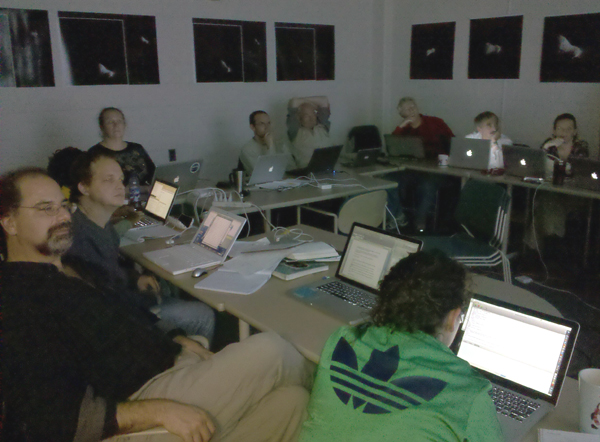 EPOXI missions scientists spent the first week after encounter at UM processing data in preparation for an upcoming press briefing.
EPOXI missions scientists spent the first week after encounter at UM processing data in preparation for an upcoming press briefing.
CW starting with person in green: Silvia Protopapa, Casey Lisse, Tony Farnham, Jade Williams (hidden behind Tony), Karen Meech, Frederic Merlin, Jochen Kissel, Don Lindler, Pete Schultz, Lori Feaga.
Credit: Elizabeth Warner/UMD
2010-11-17... One week with Hartley 2
You may be wondering why there have not been any new posts on the blog. Well, I have to admit that I have been doing other things. Now that we have a wonderful set of data from comet Hartley 2, we have to work on it. And, because we have a press conference this Thursday on some great new science results, the past week has been very intense! In fact, it was surprising to me that last week was even more intense then the previous 10 days at JPL. You may remember me mentioning that after the encounter, many science team members were going to come spend a week at the University of Maryland. When we all came back home on Monday the 8th, we naturally decided to gather in the conference room and work together. Yes, we missed each other so much that we decided to spend one more week together in the same room. This was yet another wonderful experience where we achieved a lot of science. Everybody was working on his/her laptop and as soon as one of us had an image, spectrum, plot, or result to share, we'd grab the cord of the video projector to present it to the others. That was by far the biggest "Science Week" of my life! And, you will be able to see all of these new results this Thursday, November 18th, on NASA TV at 1pm EST (18:00 UTC).
 Shortly after the first images were downloaded, Sebastien and Tony both see something interesting on the big screens and then get right to work!
Shortly after the first images were downloaded, Sebastien and Tony both see something interesting on the big screens and then get right to work!
Credit: Elizabeth Warner/UMD
2010-11-06... The days after
It is only the second day after closest approach, but to me it seems like a week ago. Some of the science team members have already left JPL, some remain because we are still waiting for important data to come down from the spacecraft. People are tired, you can see it on their faces. The good news is that we are going back home tomorrow. It is in the mean time a little bit sad. However, going home does not mean we are going to rest -- we have wonderful data to analyze and more data coming every day. Yesterday, we had our first daily science meeting after encounter. That was very great. We started to put all the ideas, images, and spectra into a story that will for sure increase our knowledge of comets. I will continue to post some blogs during the next couple of weeks, so that you can have a taste of what happens after the flyby.
When you do a flyby, you only have one shot. This is why everything was so concentrated during one week. This was a tough week, but for sure I wish I will be able to do it again in the future.
2010-11-04... What a comet!
Honestly, I do not know what to tell you. This experience is not yet over, and so far, it has been something wonderful. We all woke up very early to see the first images coming back from the spacecraft. And all our efforts were rewarded by a fantastic set of images of comet Hartley 2.
I hope you have all seen the images of the nucleus that show wonderful features on the surface and activity beyond our expectations. You also have seen a lot of the control room on NASA TV, but what about the science room? Well, we were looking at the screens that display the images and waiting, waiting, and waiting. Then the first image arrived and there was an explosion of cheers and astonishment. In a blink of an eye scientists were pointing to features on the nucleus and speculating (because scientists are good at that!!). The next hours were used to prepare all of the material for the press conference. That was quite a rush but I think it was very exciting to prepare all of that for you.
Things are now returning back to "normal," checking the data that are still being downlinked, and there are a lot. But in the mean time, we have printed some large images of the five from closest approach so that we can discuss the nucleus and jets. This flyby experience has been amazing, and the science part looks even more fantastic.
2010-11-03... "Jour J"
In French, we are used to saying: "C'est le jour J".
Yes, tomorrow is the big day, the one we have been waiting for since the end of the primary Deep Impact mission. These last few days have been very intense and we are eager to see the nucleus of the comet. In fact, what we have seen so far in the coma raises a lot of questions and we are really wondering what the nucleus looks like.
On a personal matter, this is so much more of a wonderful experience than I could have ever imagined. Discussing and interacting with the whole science team, the engineers at JPL, and the media is a very good experience I wish we could do more often. However, this is also a very tiring experience and you don't want to have to do it everyday. Looking around, you can see that everybody is tired. Because of overnight duties, some people weren't able to sleep at all last night, and others didn't get much sleep!
It is late afternoon now and time to go to bed, try to sleep and be ready for the fireworks which start very early tomorrow morning.
I am not sure if I will be able to sleep very well, I am too excited.
2010-11-01... Image Release #11
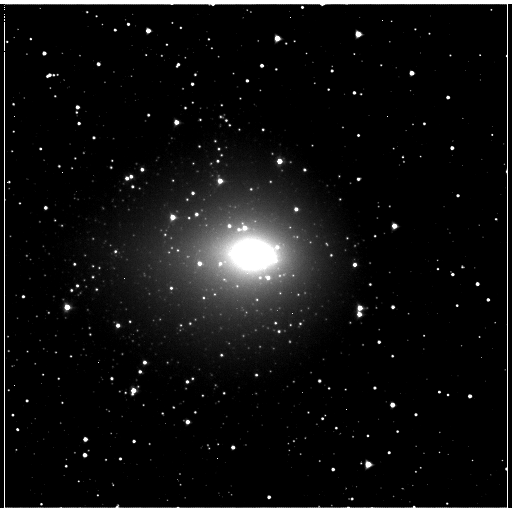 Image Release #11 shows 103P/Hartley 2 as a faint fuzzy blob among fewer stars. It is a composite of 4x60sec exposures.
Image Release #11 shows 103P/Hartley 2 as a faint fuzzy blob among fewer stars. It is a composite of 4x60sec exposures.
Read More...
2010-10-31... Image Release #10
 Image Release #10 shows 103P/Hartley 2 as a faint fuzzy blob among fewer stars. It is a composite of 4x60sec exposures.
Image Release #10 shows 103P/Hartley 2 as a faint fuzzy blob among fewer stars. It is a composite of 4x60sec exposures.
Read More...
2010-10-30... Image Release #9
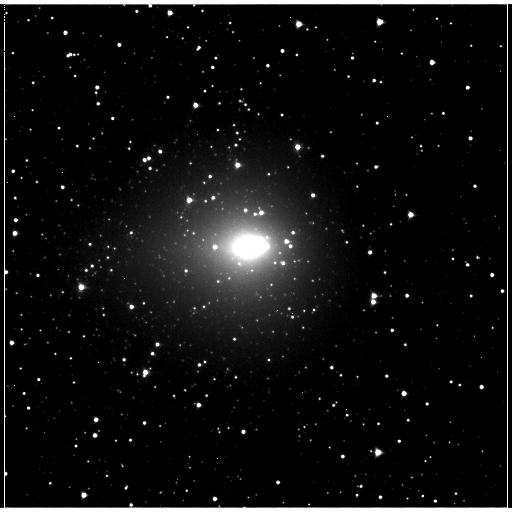 Image Release #9 shows 103P/Hartley 2 as a faint fuzzy blob among fewer stars. It is a composite of 4x60sec exposures.
Image Release #9 shows 103P/Hartley 2 as a faint fuzzy blob among fewer stars. It is a composite of 4x60sec exposures.
Read More...
2010-10-29... Image Release #8
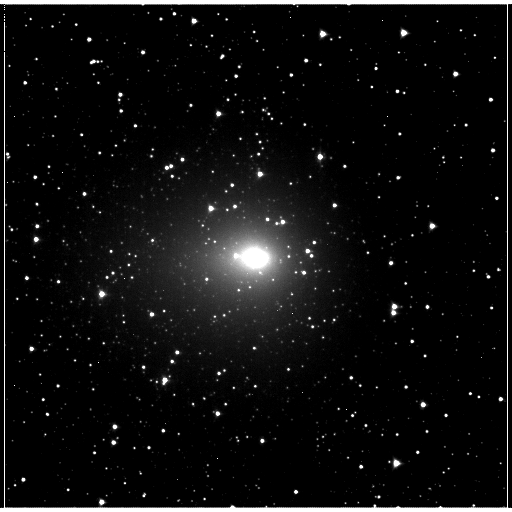 Image Release #8 shows 103P/Hartley 2 as a faint fuzzy blob among fewer stars. It is a composite of 4x60sec exposures.
Image Release #8 shows 103P/Hartley 2 as a faint fuzzy blob among fewer stars. It is a composite of 4x60sec exposures.
Read More...
2010-11-02... All Together Now!
We are all together now, the remaining science team members have arrived at JPL and this is good timing because things are getting interesting. As usual, we start our day by looking at the data that were downloaded during the night.
Now, the comet is closer to the spacecraft. Consequently, the spectra and the images are more impressive! We display the data on several projection screens for inspection by the science team. Sometimes, we can hear scientist screaming with excitement when interesting data are displayed (even me when I look at the spectra from the infrared telescope!!). These days have been very intense, a lot of things have been done and some still remain to be done. We are confident. I really think we are ready for the flyby... we are just waiting for you Hartley 2!
2010-11-01... Getting closer and closer...
Not many days left before encounter and each day is more and more intense. Because we know that Monday through Friday are gonna be crazy, we decided to have a "light Sunday." As you can imagine, this is all relative. Some of us took that opportunity to visit family, others to rest so that everyone has a full battery for next week. However, during the day, we watched the data and saw different species in the coma getting stronger and stronger. The daily meetings are longer and longer because we have more and more science to be discussed. We can summarize by saying : "We have more and more of everything; data, science and excitement!!"
2010-10-31... Weekend, what weekend?
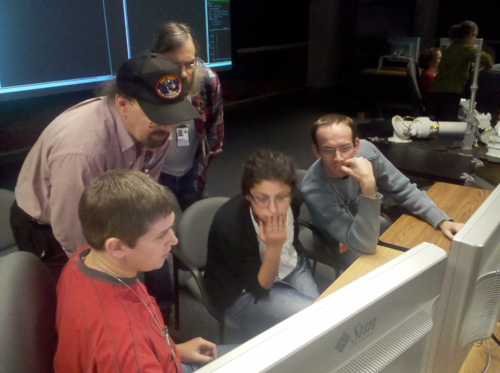
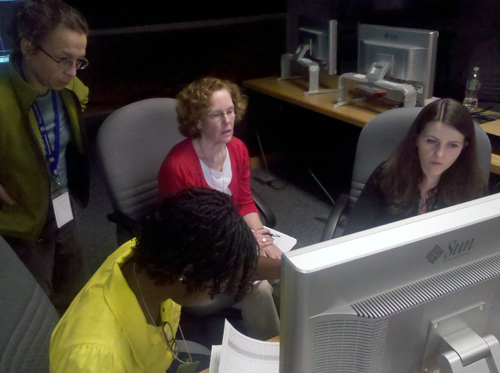
 Reviewing incoming data to verify that we get all of the science data that we expected as well as monitoring for corrupt and missing frames.
Reviewing incoming data to verify that we get all of the science data that we expected as well as monitoring for corrupt and missing frames.
Top: (l-r) Sebastien Besse, Dennis Wellnitz, Steve Collins, Silvia Protopapa, Frederic Merlin
Middle: (l-r) Stef McLaughlin, Jade Williams, Lucy McFadden, Megan Bruck
Bottom: Mike A'Hearn along with Jessica Sunshine and Mike Belton review raw spectra of the comet.
Credit: UMD/Elizabeth Warner
The spacecraft does not take a break because it is the weekend, so we continue working also. However, when you are part of such a project, it is a pleasure to come watch the incoming data. And each day is more exciting than the previous one because we have more data and the science coming out of this comet looks more and more interesting. People are now used to the tasks they have to do and things are progressing well.
We have also started to have our regular daily meeting so that we can discuss the data and the scientific results we already have. It is very impressive to have 30 people together in a room discussing the latest data and results. And every person has something to say -- scientist, engineers, grad and undergraduate students...
2010-10-29... Arriving at JPL
The flyby of the nucleus is Thursday and we finally arrived at the Jet Propulsion Laboratory (by we I mean the science team). It is very important for us to arrive in advance because we need to be ready for next week and trained to do all the various tasks we will have to do. It is exciting to all be in the same room, everybody is concentrating hard on what they are doing, and there are lots of things to do: check the data that we just downloaded, be sure that the spacecraft is behaving as expected and start doing some science with the images. We also have discussed what we will release to the public so that you guys can have the best images of the comet. All of this takes a lot of time and by the end of the day, we are all tired but happy with the progress we are making!
2010-10-27... Comet in the IR
As you can see in our gallery below, we've done it, we have observed the comet in the infrared telescope. We were just waiting to have enough signal for a detection, now it is detectable and this is very exciting. At first, it was not easy to find Hartley 2, everybody involved with the infrared spectrometer tried to find it. And the problem is, the more you are looking for something, the more you think you actually found it. Your mind can trick your eye and most of the time, it was not the comet. Now, we are sure we have detected it, and we are starting to see variation in the coma composition as it as been observed with the MRI images. Flyby is just a week from tomorrow, and there is still so much to do!
2010-10-23... Image Release #7
 Image Release #7 shows 103P/Hartley 2 as a faint fuzzy blob among fewer stars. It is a composite of 3x60sec exposures and is from the first set of images taken on E-12.
Image Release #7 shows 103P/Hartley 2 as a faint fuzzy blob among fewer stars. It is a composite of 3x60sec exposures and is from the first set of images taken on E-12.
Read More...
2010-10-22... Image Release #6
 Image Release #6 shows 103P/Hartley 2 as a faint fuzzy blob among fewer stars. It is a composite of 3x60sec exposures and is from the first set of images taken on E-13.
Image Release #6 shows 103P/Hartley 2 as a faint fuzzy blob among fewer stars. It is a composite of 3x60sec exposures and is from the first set of images taken on E-13.
Read More...
EPOXI Discovers Unusual Cometary Activity
 This is a light curve of comet Hartley 2 derived from the Deep Impact (DI) spacecraft Medium Resolution Instrument (MRI) data from the beginning of the approach phase, September 5, through October 14...
This is a light curve of comet Hartley 2 derived from the Deep Impact (DI) spacecraft Medium Resolution Instrument (MRI) data from the beginning of the approach phase, September 5, through October 14...
Read More...
103P Detected in the IR
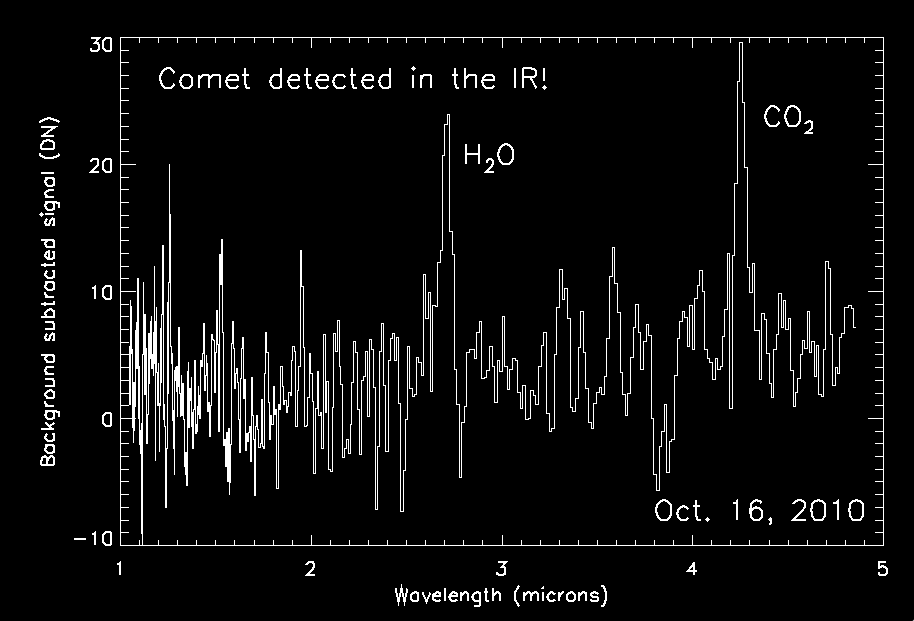 103P/Hartley 2 has been detected with the High Resolution Instrument's infrared spectrometer (HRI-IR). The spectral data from October 16, 2010, show emissions above the noise level from ...
103P/Hartley 2 has been detected with the High Resolution Instrument's infrared spectrometer (HRI-IR). The spectral data from October 16, 2010, show emissions above the noise level from ...
Read More...
2010-10-20... Visit to JPL
While we were at the DPS conference (see previous post), we went to the Jet Propulsion Laboratory (JPL) which was a few miles away from the conference center and is the NASA facility in charge of the mission operations. This visit was important because it allowed us to get our ID badges, which are needed when we come back in late October for the flyby of Hartley 2. Once our badges were ready, we were able to tour the room where the science team will be working during encounter. It was important to come here and see what resources were available and what needs to be changed in the room so that it is in the best configuration for us to work during encounter. After that first visit, we went to JPL's mission control center, the building and room where the staff from JPL control the spacecraft. From a personal perspective, it was very exciting to be here. In fact, this the place you see on TV after all successful JPL missions with people congratulating each other. It was even more exciting that they have already put the EPOXI logo in the control room, and you can also find a countdown to closest approach. All of that makes you feel like the flyby will happen very soon, and indeed, encounter is only 2 weeks away!!
2010-10-14... Image Release #5
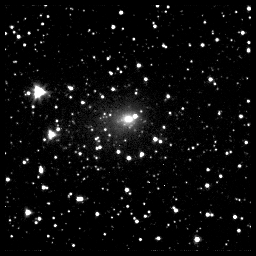 Image Release #5 still shows 103P/Hartley 2 as a faint fuzzy blob! It is a composite of 3x60sec exposures and is from the first set of images taken during the E-34 to E-8 image sequence.
Image Release #5 still shows 103P/Hartley 2 as a faint fuzzy blob! It is a composite of 3x60sec exposures and is from the first set of images taken during the E-34 to E-8 image sequence.
Read More...
2010-10-14... First IR Scans
A few days ago, we turned on the infrared spectrometer in order to acquire data at other wavelengths in addition to the visible light we had used to image the comet in the E-60d to E-40d sequence. The cameras only observe in the visible range (up to 1 micron) while the infrared spectrometer "sees" from 1 micron to 5 microns. The wavelengths of the spectrometer are very important to detect the different volatiles (gasses) present in the coma environment, especially the water molecules. The first step for the science team is to get the data and find the comet. This is not an easy thing to do when you are far away from the comet and the comet is not very bright in the infrared. And, as in the visible light images, stars can also be a problem in the infrared. Indeed, at first we thought that we had the comet but it turned out to be a bright infrared star. As you can imagine, we were a little stressed not to find the comet. However, we know that we are looking at the right place, the comet is just not bright enough to be seen with the infrared spectrometer yet. We are looking forward to the first detection of the comet in the spectrometer which should be soon!
2010-10-06... DPS Meeting
This week we have the Division for Planetary Sciences conference which is one of the most important conferences for small bodies of the Solar System (like comets, asteroids, KBO's and moons). Although we do not yet have results to present from the EPOXI/DIXI observations, it is important for us to attend this conference so that we can meet our collaborators who are also observing Hartley 2 as I told you in the previous post.
However, the spacecraft does not stop taking data while we are busy doing other things. As a result, as soon as there is a break between talks, we jump on our laptops to download the latest images and see how things have changed in the coma environment. And of course, the comet is not waiting for us. Because most of the science team is present at the meeting, it is easier to discuss the latest results. Things get more exciting every day.
2010-09-29... Baseline Comparisons
As I told you in a previous post, images of the coma taken trough different gas filters (filters that allow us to see the different gasses present in the coma, mainly OH, C2, CN) give us information on the composition of the coma and its variations. However, it is difficult to understand and interpret the variations we see in the images because we do not have a long baseline of data with which to compare. It is like trying to understand if the temperature of the last summer were hot if we do not have records of previous years.
Consequently, the science team is collaborating with many astronomers who have observed comet Hartley 2 in the past months using ground- or space-based telescopes. Observations made at Lowell Observatory (M. Knight) along with observations obtained through the WISE space telescope (G. Bauer) and the Hubble Space Telescope (H. Weaver) have been helpful to understand the evolution of the brightness of the coma we see in the DIXI images. Some long baseline comparisons from previous apparitions are also used, especially from SOHO/SWAN (M. Combi).
2010-09-25... Image Release #4
 From E-60 to E-50, the spacecraft was taking batches of images roughly every 6 hours. From E-50 to E-40, the cadence changed to batches getting collected every 2 hours. This composite is from the last batch on E-40. The spacecraft is taking a break and will resume collecting images on E-34. During the hiatus, the spacecraft will perform a Trajectory Course Maneuver (TCM).
From E-60 to E-50, the spacecraft was taking batches of images roughly every 6 hours. From E-50 to E-40, the cadence changed to batches getting collected every 2 hours. This composite is from the last batch on E-40. The spacecraft is taking a break and will resume collecting images on E-34. During the hiatus, the spacecraft will perform a Trajectory Course Maneuver (TCM).
Read More...
2010-09-20... Image Release #3
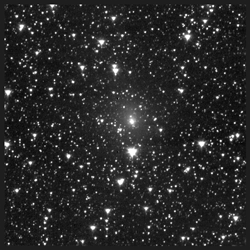 This week we had a different person do the post-processing of the combined stacked image. The 'min' set point and 'range' affect the on-screen appearance so it is done uniquely for each image. Later on, as we have more images, we will likely go back and re-do the post-processing on some of these early images using a more universal set of 'min' and 'range' values.
This week we had a different person do the post-processing of the combined stacked image. The 'min' set point and 'range' affect the on-screen appearance so it is done uniquely for each image. Later on, as we have more images, we will likely go back and re-do the post-processing on some of these early images using a more universal set of 'min' and 'range' values.
Read More...
2010-09-20... Tasks for Encounter
Observations of comet Hartley 2 taken through visible and near infrared filters are now arriving every day. The comet is still a tiny smudge in the images. Another instrument, the infrared spectrometer will be turned on later when the comet is larger in the field of view. It is very rewarding to see that everything is going well, since many people have spent so many hours preparing for the acquisition of these images.
In the meantime, the science team discusses the tasks each scientist will have during the encounter (time of closest approach) on 4th November. These tasks need to be defined now so that everybody is ready for encounter and can quickly process some of the data for sharing with the public as soon after encounter as possible. As for me, one of my tasks will be to prepare something called an "image cube" with data from the infrared spectrometer so that we can see at the same time the variation in mineralogy and the location of these variations on the nucleus.
2010-09-13... The Next Image
2010-09-13... The First Week
One week has gone by since we started receiving data from the two cameras. Many of you probably wonder what we are doing with the data, what can we say about the comet when it is just a tiny point on the CCD. Scientists do not need much information to initiate scientific discussions, and those discussions started as soon as we received the first image. The data we acquire will allow us to see the variation of brightness of the nucleus, which can give us information about the rotation period (24h in the case of Earth) and the activity of the comet nucleus (jets, outbursts). Of course, we need more information to confirm the first impressions we have, which is why we will continue to monitor the comet until we reach closest approach.
2010-09-08... The First Image
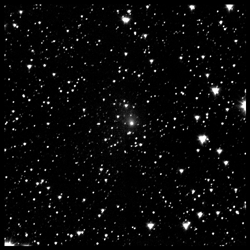 Read More...
Read More...
UM Press Release
JPL Press Release
2010-09-07... My Impression of the First Image
Every week, we have our weekly DIXI Team telecon. These telecons are really useful, especially last week's, the importance of which became apparent yesterday! The "big boss" of the mission, Dr A'Hearn, reminded us at the end of the last telecon that the first images would be arriving this week. That was a wake up call for me because you work so hard for these images that you almost forget they are almost here. Yesterday, everybody was waiting for the first images of comet Hartley 2... and all the images arrived on Earth as expected! Wonderful, and we also received congratulations from the Deputy PI and the Project Manager. Of course, I grabbed these data as soon as possible and took a look at it. What is my first impression: well, happy that we have the data we planned to take but I am also disappointed because the spacecraft is still so far away from the nucleus that it is a very tiny point on the image. You should not forget that the instruments are designed for close range observations, so this is just the beginning. Go DIXI, GO, GO!!
2010-09-02... Hello!
 Hi, my name is Sebastien Besse. I am a member of the EPOXI Science Team and I am very excited about the upcoming flyby of comet Hartley 2. My intent for this blog is to share with you my excitement in being part of such an adventure as a young scientist. I will share with you my feelings and impressions along the way and you, the audience, can experience how things change as we get closer and closer to the comet. My entries will increase in frequency as we approach the comet. By reading them, I hope you will feel like you are a part of this marvelous journey to the origins of our cosmos.
Hi, my name is Sebastien Besse. I am a member of the EPOXI Science Team and I am very excited about the upcoming flyby of comet Hartley 2. My intent for this blog is to share with you my excitement in being part of such an adventure as a young scientist. I will share with you my feelings and impressions along the way and you, the audience, can experience how things change as we get closer and closer to the comet. My entries will increase in frequency as we approach the comet. By reading them, I hope you will feel like you are a part of this marvelous journey to the origins of our cosmos.
2010-09-01... Intro to The Daily Comet
New Feature! As you already know, there are some really cool people working on the mission. Dr. Sebastien Besse joined the team last year as a freshly minted PhD! He's been learning the ins and outs of the mission and now that we're ramping up activities for encounter in early November, he's decided to share his experiences in a blog format.
We also start regularly taking images of our target comet Hartley 2 on September 5. We'll be taking lots of pictures, but while we are still far away, there won't be significant changes in the comet's appearance, so we'll just post a picture per week. As we get closer we'll start to see the comet better and we'll post pictures more often. Shortly before encounter, we plan on posting a picture per day.

